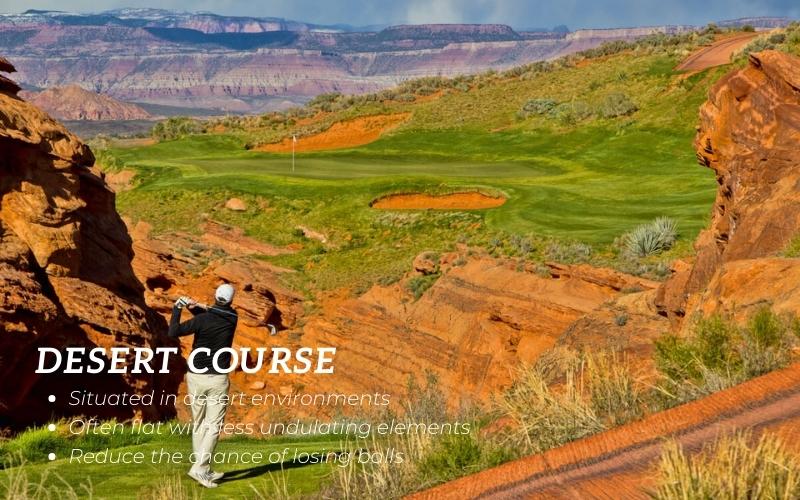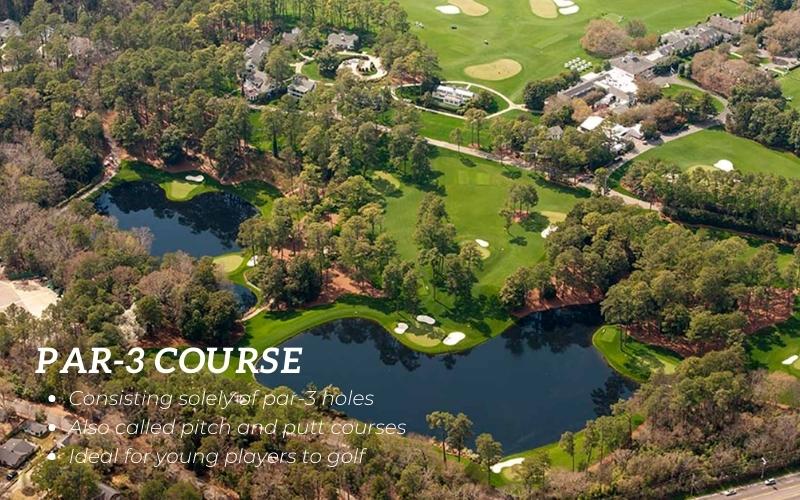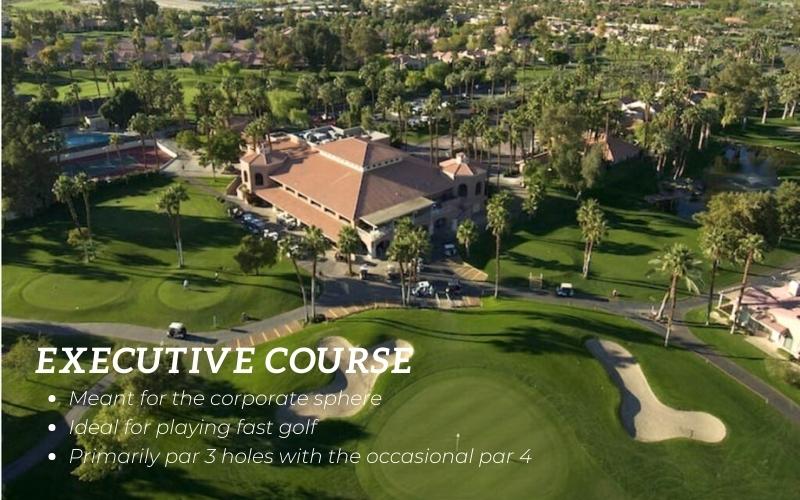What Are the Different Types of Golf Courses?

Golf courses, like most things, are not all cut from the same cloth. Their design is significantly influenced by the indigenous terrain and ecosystem. While you might not be behind the design, adapting your gameplay to fit different types of golf courses can give you a competitive edge. In the following article, we will guide you through a diverse landscape of golf courses, highlighting their common features and mentioning some renowned examples.
Different Types of Golf Courses
Links Course

Links course
The links course stands out as a prevalent type in the golfing world. If you’re wondering, “What exactly is a links golf course?”, you’re not alone. This course style is among the most venerable, tracing its roots back to England and Scotland, where golf first began.
Given that the sport dates back to the 15th Century, some view links courses as relics. Nonetheless, they’ve resiliently endured through the ages, their popularity undiminished, perhaps buoyed by golf aficionados’ appreciation for the sport’s rich history.
Links courses predominantly grace coastal areas, especially throughout much of Europe. Characterized by their relatively gentle terrains, and rolling elevations, these courses provide clear sightlines for your shots. The firm ground ensures that balls get a generous roll.
Imagine standing on the Swilken Bridge over the Swilcan Burn on St. Andrews’ iconic 18th Hole. The quintessential links course evokes images of vast expanses devoid of trees or water, replaced by unique challenges – like unnaturally lengthy rough patches or deep bunkers, from which even seasoned players might struggle to break free. Proximity to the coast guarantees breezy conditions, but players with precision can thrive. Those who tend to be erratic, especially off the tee, might brace for a challenging round.
Renowned examples of links courses include Scotland’s Old Course at St. Andrews, Royal Portrush in Northern Ireland, and the picturesque Pebble Beach in California.
Parkland Course

Parkland course
Parkland courses are often built inland, off the coast. They are characterized by their verdant landscapes dotted with trees and lush greenery. If you’re an avid PGA Tour viewer, Parkland courses would be no stranger to you. Their name aptly describes the ambiance they encapsulate – it’s akin to teeing off amidst the serene settings of a park. Typically, these courses are meticulously groomed, and enriched with artificial elements like crafted bunkers, water features, and intensified roughs.
Often, parkland courses sprout in regions not naturally predisposed to golf, making their maintenance more challenging and costly. The terrain’s lack of inherent undulations and variety demands more from course architects, pushing them to innovate to instill the course with appeal and zest.
A shining jewel in the realm of parkland courses is Augusta National, which is widely recognized as one of the globe’s most iconic courses.
Healthland Course

Healthland course
To understand what a healthland course is, you might start by defining “health.” Healthland course refers to an open, unspoiled land, primarily in Britain, bearing vegetation like heather, gorse, and rough grasses. Predominantly located in Britain, heathland courses are inland spaces, drawing inspiration from the design of links courses, making them more open than their parkland counterparts.
Signature features of these courses include the ubiquitous presence of gorse and heather, lending them a more natural, less groomed appearance compared to the pristine parkland courses. Over time, many heathland courses, originally sparse in tree cover, have seen a gradual proliferation, especially of pine trees.
Born from the desire to expand golf terrains beyond the traditional links, heathland courses mirror the characteristic undulating terrain and sandy soil of the latter. Some of the most prestigious heathland courses include Woking Golf Club, Sunningdale Golf Club, and Alwoodley Golf Club.
Championship Course

Championship course
A championship course may be one of the most prominent types of golf courses coming to your mind. It is less about the design but more about what it is. Actually, there are different ways to define a championship course, such as:
Definition 1:
In golf courses boasting 36 holes, one of the 18-hole courses is typically designated as the “championship” course. This one tends to be more challenging and is maintained to a higher or equivalent standard compared to its counterpart. With the “championship” label, the course can command a premium fee, making it particularly enticing for first-time visitors.
If you’re at a complex with two sets of 18-hole courses and are unsure which one is the championship course, a glance at the pricing might give you a hint. If prices are on par, inquire about the venue of their club championship. Typically, the premier course hosts the primary tournaments.
Definition 2:
In some instances, the championship course title arises from the tournaments the course has hosted. Whether these tournaments are local, state-level, or professional, the course’s reputation determines its “championship” status. It’s rare for individuals to label a course as “championship”; instead, the designation gains traction among broader groups over time.
In essence, a championship course is precisely what the name suggests, devoid of rigid standards or criteria. The term’s interpretation varies, depending on who you’re conversing with. Ultimately, the identity of a championship course is subjective and can be molded as one sees fit.
Desert Course

Desert course
Desert golf courses, as the name implies, are situated in desert environments. While not entirely made of sand, they are encompassed by it. The desert’s expanse might range from a mere 5 yards to 50 yards away from the primary playing area.
When tackling a desert course, the primary objective might sound like fun, but in reality, it’s to keep the ball on the grassy path and away from the sandy stretches. Players who manage to maintain their game on the grass often fare better than those who stray off and grapple with the challenging desert terrain. It seems like a straightforward strategy.
One advantage of desert courses is the reduced likelihood of losing balls, though they can pose a challenge in gameplay. For those unfamiliar with desert landscapes, these courses offer a novel and thrilling experience. They are predominantly flat, with fewer surprise elements and less obscured shots than other golf course types.
A notable mention among desert golf courses is The Quarry at La Quinta in California, which has made its mark on the Golf Digest top-100 list. In the United Arab Emirates, you will also find a desert golf course named Al Ghazal Golf Club.
Par-3 Course

Par-3 Course
A course consisting solely of par-3 holes is called a par-3 course. Sometimes, these are also called pitch and putt courses. While most golf courses have nuanced names, a par-3 course is straightforward – it’s primarily made up of par-3 holes, with occasional exceptions.
The term “pitch and putt” signifies courses with holes short enough that a simple pitch shot is all that’s needed to navigate them. The nuanced difference between the two is that pitch and putt courses might feature a par-4 hole here or there. This subtle inclusion is what differentiates it from a full-fledged par-3 course.
A par-3 course is an ideal setting for introducing newcomers or young players to golf. The shorter distances, coupled with a more relaxed ambiance compared to a standard course, make for quicker play, reduced strokes, and lower scores. Typically, par-3 courses can be situated anywhere and often consist of just 9 holes. Predominantly, their more compact nature, rather than a lack of ambition, is what differentiates them from regular-length courses.
>>> Check out our list of Best Par-3 Courses in the world and try adding them to your travel bucket list if you are new to this sport.
Executive Course

Executive Course
Looking for a shorter golfing experience with diverse holes? Consider an executive golf course. While it shares similarities with a par-3 course, boasting numerous par-3 holes, the executive course also invites players to wield their drivers a few times. It’s not unusual to find an executive course with a full set of 18 holes.
The “executive” moniker harks back to its origins when such courses were linked with the corporate sphere. Several firms established these courses for their staff, primarily catering to high-ranking employees who could indulge in a swift morning or afternoon game.
Today, the exclusivity once associated with executive golf courses has largely faded. They aren’t reserved for a select corporate crowd but are generally open for public play. Though they aren’t as widespread, you can find executive courses scattered nationwide. They offer an excellent choice for novices or anyone keen to complete an 18-hole round in a shorter time frame.
Which are the Most Pro Types of Golf Courses?
The majority of professional golf tournaments are hosted on links or heathland courses. These types, being some of the oldest and most prevalent, are often modified to present a more rigorous challenge to the players’ skills.
When tuning in to a European pro tournament, it’s usually set on a links course. In contrast, while watching in the U.S., if the course is near the coast, it’s likely a link. However, if it’s situated inland, chances are you’re looking at a parkland course.
Parkland courses might seem different because many of their trees have been cleared, especially to accommodate larger audiences and camera setups. This alteration is particularly evident around tees and greens, but the essence of heathland courses shines through on the fairways.
One of the privileges of golf courses tailored for PGA-level tournaments is their nearly unlimited budget for design and upkeep. These courses aren’t restricted by the surrounding landscape. If a PGA architect envisions dramatic slopes, significant greenside drops, or even a new water hazard, they have the means to realize it.
Therefore, categorizing the golf courses the professionals play on can be ambiguous. However, the courses most frequently showcased on TV, graced by the sport’s elites, are typically links or parkland, often intertwining elements of both.
Now, you know different types of golf courses rather than a 9-hole or 18-hole layout. Most often, the type of course is determined by the environment surrounding it. Despite how many times you play on a course, there will be no two rounds ever the same. You can play yourself or against other competitors. Create a new and fun golfing experience with GolfLux now by contacting us right here. We are eager to serve you the best.
Read more:





